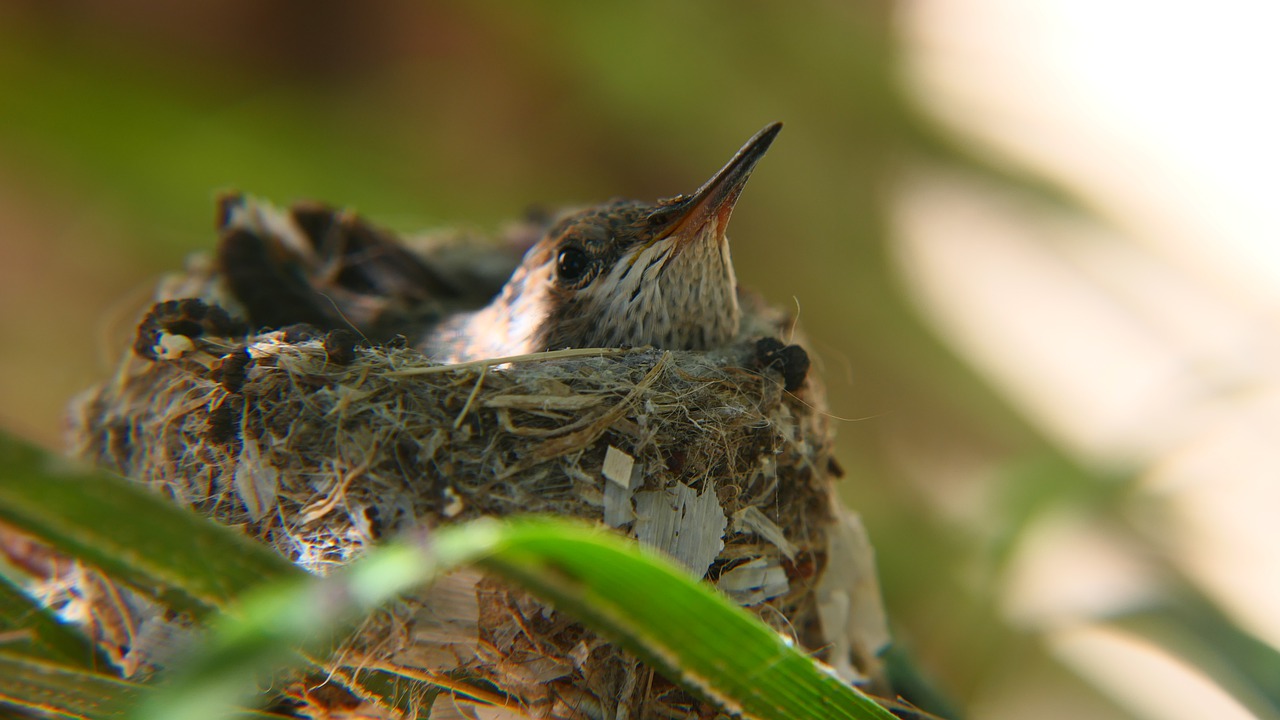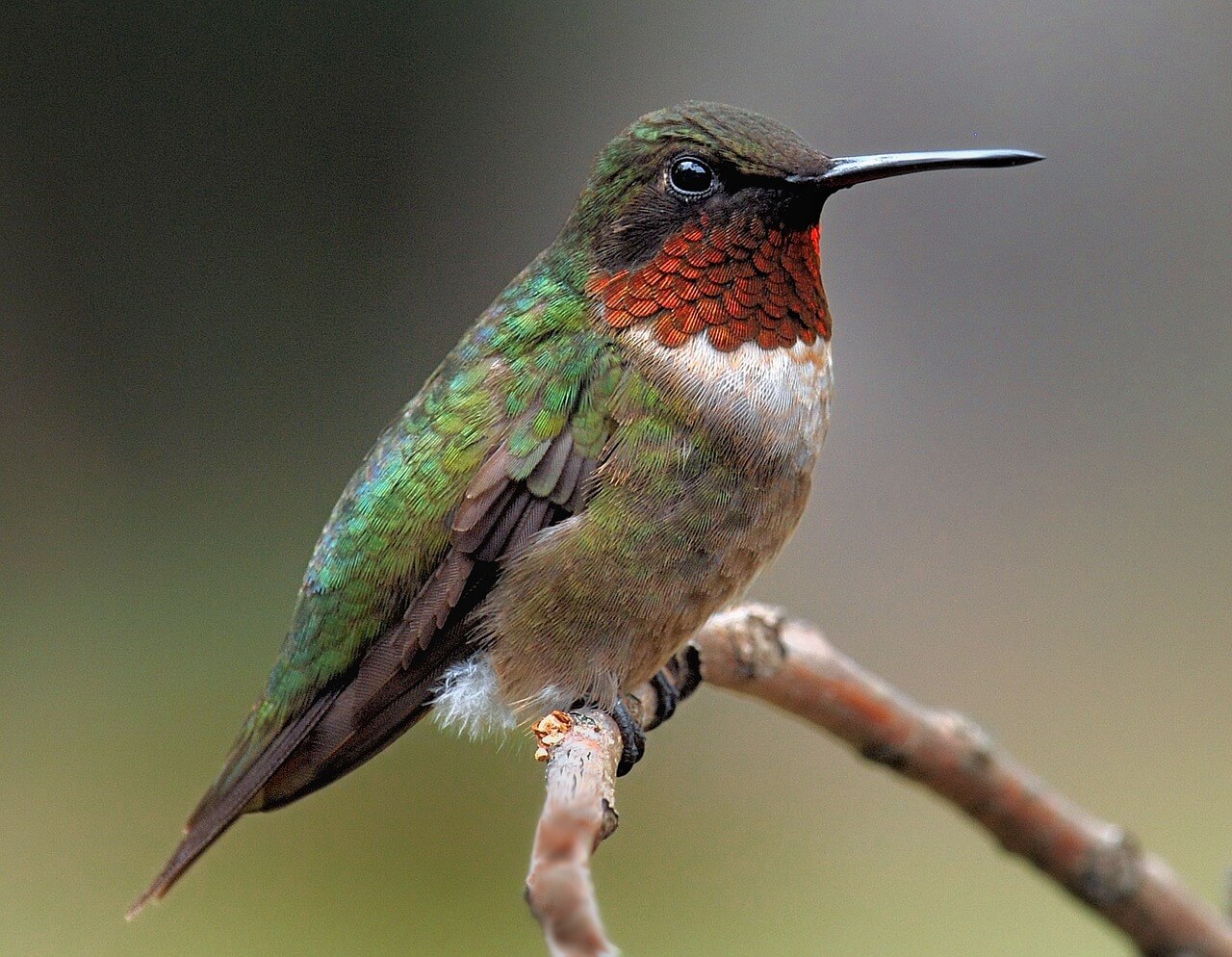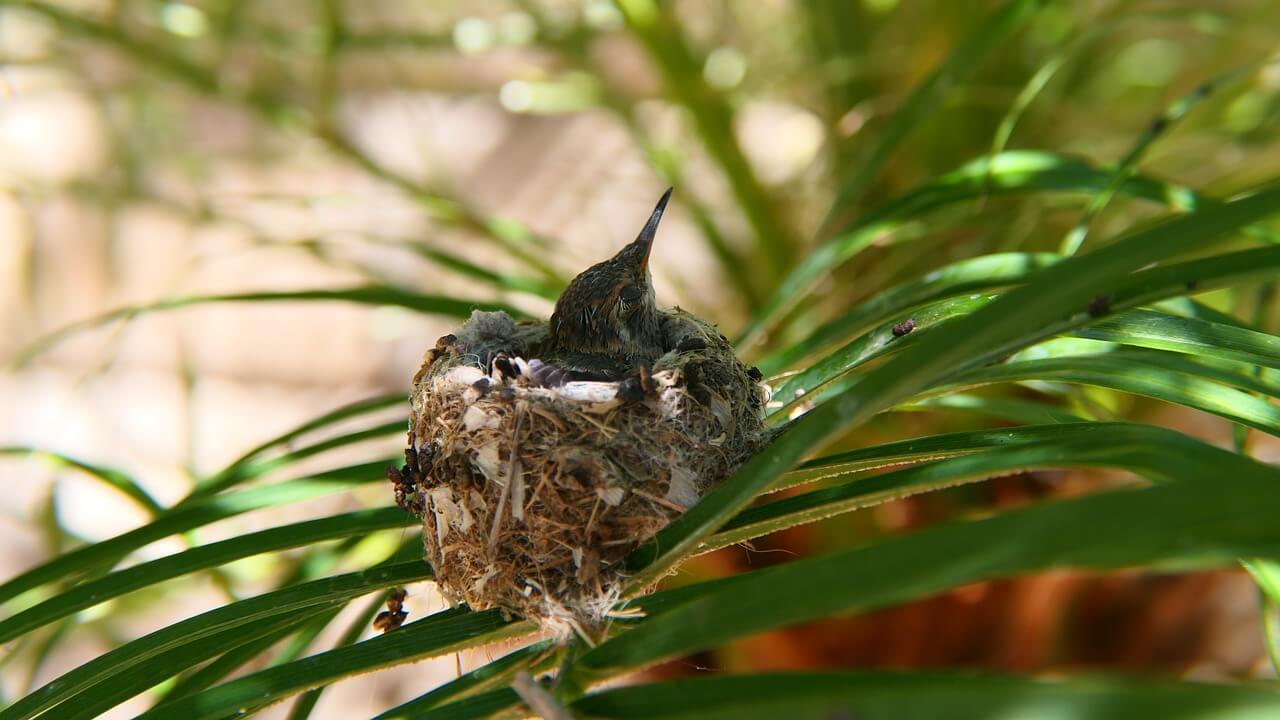Hummingbirds feed on a huge amount of nectar each day to maintain the necessary energy levels, but their babies require a more protein-rich diet to help them grow and develop. So how do hummingbirds feed their young? What do the young hummingbirds eat, when are they born, and how fast do they grow? Keep reading! In this article, we’re talking all about baby hummingbirds.
What You'll Learn Today
What Do Baby Hummingbirds Eat?

Baby hummingbirds are incapable of feeding themselves for the first few weeks of their life. What’s more, they need a diet higher in protein and lower in sugar so they can grow and develop properly.
Young hummingbirds eat a combination of nectar and small insects such as ants, mites, gnats, and mosquitoes. The mother bird feeds her babies by first eating the nectar and insects herself, then using her beak to funnel the regurgitated mixture down the babies’ throats.
Only the mother hummingbird feeds and cares for her young. She also does all of the nest building and incubation duties.
Adult hummingbirds require frequent feedings, and their offspring are no different. Hummingbirds feed their babies 2 to 3 times every hour for the first 3 or 4 weeks of life.
Because of these frequent feedings, as well as their need to stay in the nest and keep the babies warm, mother hummingbirds tend to build their nests within easy distance of food sources.
They will pluck insects off branches, grab them in midair, and take a quick buzz over to the nearest flower or hummingbird feeder to get the nutrition they need for themselves and their young.
When Do Hummingbirds Have Their Babies?

Cold weather can kill baby hummingbirds, and many species migrate to warmer climates during the winter. For these reasons, hummingbird babies are usually born during the late spring and summer.
In cooler regions, hummingbirds may only have one or two broods per year. They may have additional broods once they have migrated to their winter homes.
In regions where it is warm year round and the birds don’t have to migrate, they can have babies at any time of the year. Hummingbirds in these areas may have several broods each year.
What Time of Year Do Hummingbirds Lay Their Eggs?
Regardless of the region or climate, hummingbirds most often lay eggs in May. Usually, by this time, the danger of a late frost is past and there are plenty of flowers and insects for food sources.
In warmer regions, hummingbirds may lay eggs from late winter through late fall. According to Hummingbird Bliss, the Allen hummingbird of southern California will lay its eggs as early as February and as late as November.
Why Do You Never See Baby Hummingbirds?

Obviously, hummingbirds are a lot smaller than the other birds you may have hanging around your neighborhood. You might assume you’ve never seen a baby hummingbird simply because they are even smaller than the adults, but that’s only one part of it.
There are actually several reasons why you don’t see baby hummingbirds, including:
They Stay in the Nest Until Nearly Grown
Most baby hummingbirds stay at home until they are almost the same size as their mother. With that in mind, it’s entirely possible you have seen a juvenile hummingbird, you just didn’t recognize it as such.
Since smaller hummingbird babies don’t leave the nest, you would have to first find a nest in order to get a glimpse of the babies. Which brings us to our next point:
The Nest is Hard to Find
Hummingbird nests are only about an inch or two in diameter–roughly the size of a ping pong ball. These tiny little nests are usually built of twigs and mosses held together with spider silk, so they are made to blend into their surroundings.
Mother hummingbirds intentionally build their nests in thick vegetation and hard-to-reach spots to help protect their babies. So if you don’t know exactly where to find the nest, chances are you won’t see it even if you go looking for it.
And even then, if you do happen to stumble across a hummingbird nest, there’s a good chance you’re going to be chased away by an overprotective mother hummer!
The Babies Grow Fast
Baby hummingbirds reach maturity about 4 weeks after hatching. They are nearly the same size as their parents by three weeks of age.
In other words, they don’t stay young for very long, so you don’t have a very large window of opportunity to see the babies when they’re young. Considering they are nearly mature before they even leave the nest for the first time, your chances of seeing a baby are even slimmer.
If you want to see what hummingbird babies look like as they grow, check out the following video:
When Do Baby Hummingbirds Leave the Nest?
As baby hummingbirds grow, they strengthen their wings by “practice flying” while holding onto the nest with their tiny talons. This is an important part of the fledging process that begins around 10 days to 2 weeks after the baby is born.
Most baby hummingbirds first leave the nest 18 to 22 days after hatching. They may explore the branches just outside the nest before this time, but they almost always take their first real flight around 3 weeks old.
Like many birds, young hummingbirds don’t leave permanently the first time they explore the world beyond their nest. They return home, or at least stay close by, as they grow stronger and learn how to take care of themselves.
The mother hummingbird will continue to feed her babies during this important time of learning. This period of time usually lasts for about 5 to 10 days after the baby initially fledged.
Once the babies have learned all the mother can teach them, she either chases them away from her territory or they leave on their own. At this point, about a month after hatching, the babies are considered fully mature hummingbirds.
Conclusion
Baby hummingbirds are fed a mix of nectar and small insects by their mother. The mother feeds them by sticking her long beak down the babies’ throats and regurgitating the food she has eaten.
Baby hummingbirds grow quickly and usually leave the nest around 3 weeks after hatching. The mother continues to feed them for another week or so until it is time for them to permanently leave home.
Here is our guide on where hummingbirds sleep.
Now have my 2nd nest in front of my house. This time only one baby that I can see so far but I am not disturbing the next although it is in a crawling vine arbor that is maintained by the association. I have 3 nectar feeders in a very small back yard and all my plants are designed to feed hummingbirds. I generally have summers where about 5-7 different hummingbirds come to my feeders and some love each other and play nicely and others fight! The most amazing thing to watch.
Thanks guys. Your article has given me the answer for ” How Do Hummingbirds Feed Their Young?”. Newborn hummingbirds depend on their mother for nutrition and feeding. I always wonder that how they do that. Now I has known.
A hummingbird’s diet consists of different types of insects, such as spiders, gnats, mosquitoes, and fruit flies. They also consume a lot of flowers’ nectar, which is rich in sugar – the main source of the birds’ energy.
This year 2023 in June. Just see a hummer 1x per day and feeds for 3 seconds. Suspect this is a mother and will wait and see if changes. About three weeks since saw much more frequently. Kingwood, Texas Tony